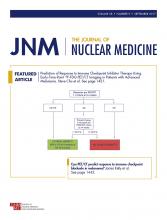REPLY: As clearly stated in the title of our article, the goal of our study was to compare overall survival between the 2 different approaches used to treat metastatic thyroid cancer with radioactive iodine (RAI) at our respective institutions: empiric versus a personalized whole-body/-blood clearance (WB/BC)–based approach (1). The maximal tolerated activity (MTA) formalism used at Memorial Sloan Kettering Cancer Center (MSKCC) is based on the standard Benua method as reported in our paper (2). The references citing previous studies of the same group on the specific recent use of recombinant human thyroid-stimulating hormone in this setting are more than adequate.
What is probably not fully addressed in our paper is that the MTA determined for each patient is only one of the critical factors that are used at MSKCC to determine the actual administered activity. The prescribed administered activity and the timing between additional activities at MSKCC was based on MTA and multiple other factors: age, metastases size, histology, 18F-FDG avidity, response to previous RAI treatments, cumulative RAI activity, comorbidity, and toxicities from previous RAI therapies. We consider MTA as a valuable piece of information that sets the upper limit of administered activity that can be safely given with respect to lung and bone marrow toxicity, but in many cases an administered activity less than the MTA is selected as we strive to maximize benefit and minimize risks. Indeed, the criticism that “Optimizing quality of life and minimizing the side effects are no less important, but not addressed in this work” is incorrect because the selection of administered activity based on MTA and other clinical factors demands a consideration of both the risks and the benefits of RAI therapy for each individual patient.
The choice of an empiric fixed activity of 3.7 GBq (100 mCi) at Gustave Roussy is historic since the early 1950s and was later confirmed by the reported favorable outcome of metastatic patients with RAI-avid metastases. In previous published series, a complete remission was achieved in 40%–50% of patients, and 96% of complete responses were reported after the administration of a cumulative activity of less than 22.2 GBq (600 mCi) (3). Additional administered activities would potentially expose the patient to greater toxicity without an expectation of significant long-term clinical benefit (4). We are not aware of any clinical data demonstrating that any method of dose assessment might produce better clinical outcomes.
Jentzen et al. comment on interpatient and intrapatient lesion heterogeneity. This comment points out, as discussed in our reply to letters by Tulchinsky and Flux, the critical importance of lesional dosimetry in patients with large tumor burden to define the optimal administered activity to achieve a therapeutic tumoricidal dose, rather than the maximum activity that can be safely delivered (5). WB/BC studies would be required only if the administered activity exceeded safe empiric activities to optimize the therapeutic efficacy while minimizing treatment-related side effects. In our experience using 124I PET lesional dosimetry, we commonly see metastatic foci that would receive a lesional dose of only a few Gy with administered activities of 7.4–11.1 GBq (200–300 mCi). In such cases, doubling or tripling the administered activity would still produce a lesional dose that is subtherapeutic while exposing the patient to higher risks. Therefore, further prospective studies are needed to define the actual administered activities to achieve therapeutic effect and to test the hypothesis that larger administered activities will achieve long-term better clinical outcomes. Finally, 124I PET scanning can estimate only the dose delivered at a macroscopic level but cannot take into account the heterogeneity of the dose distribution in tumor foci at the cell level that may increase with the lesion size. This may be a major factor of radioresistance that can be reverted by redifferentiation therapies (6).
In conclusion, science based on theoretic thoughts needs to be confirmed by prospective clinical trials that are still dramatically lacking 70 y after the initial use of RAI.
Footnotes
Published online Apr. 27, 2017.
- © 2017 by the Society of Nuclear Medicine and Molecular Imaging.







